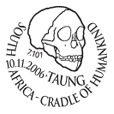Paranthropus robustus

From around 2 million to 1.2 million years ago, southern Africa was inhabited by a robust species of early human. From the original finds in 1938 and later finds in 1948, it was evident that they represented very different early human morphologies than were seen in the known Australopithecus specimens.
Adaptations of the cranium were associated with a "heavy-chewing comnplex." This complex is thought to have made it possible for these early humans to eat large amounts of tough, fibrous foods. The zygomatic arches - cheek bones - are large and positioned ffoorward on face, creating a characteristic dish-shaped face. They flare very wide, creating a large space between the arch and the skull, and opening known as the temporal fossa. Two sets of muscles are associated with the grinding action necessary to process these types of food, the masseter complex, which attaches on the bottom of the zygomatic arch, and the temporalis muscles which pass under the arch and attach to the top of the skull. The foreward migration of the cheekbones creates more space for temporalis muscles to pass under the zygomatic arch, and the increased size of the arches provides more room to accommodate a larger masseter muscle. Another feature of the robust skull is the presence, at least in males, of a prominent sagittal crest, a bony ridge that runs along the length of the top of the skull. This bony ridge provides an anchoring point for the large temporalis muscles.
These unique adaptations lead Robert Broom to place the robust early humans from southern Africa into their own genus Paranthropus. Several species names have been proposed, including P. robustus or P. crassidens. In the 1960's paleoanthropologists began to note similarities between all of the early human species before the appearance of Homo. As such, many researchers began to place all early human species into a single genus (Australopithecus) and described each species as either a "gracile" or "robust" Australopith . The robust speciemns from southern Africa were then placed in the species "Australopithecus robustus." One resercher, Milford Wolpoff, even went so far as to propose that all robust forms were really just the males and the gracile forms the females of a single early human species.